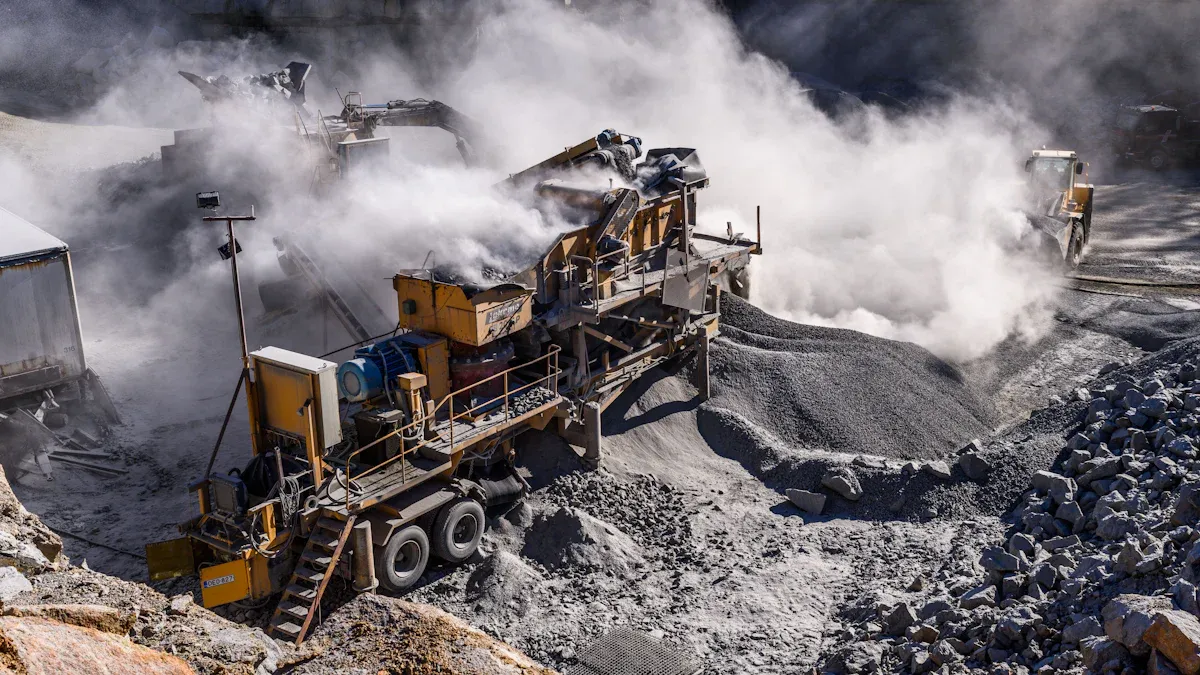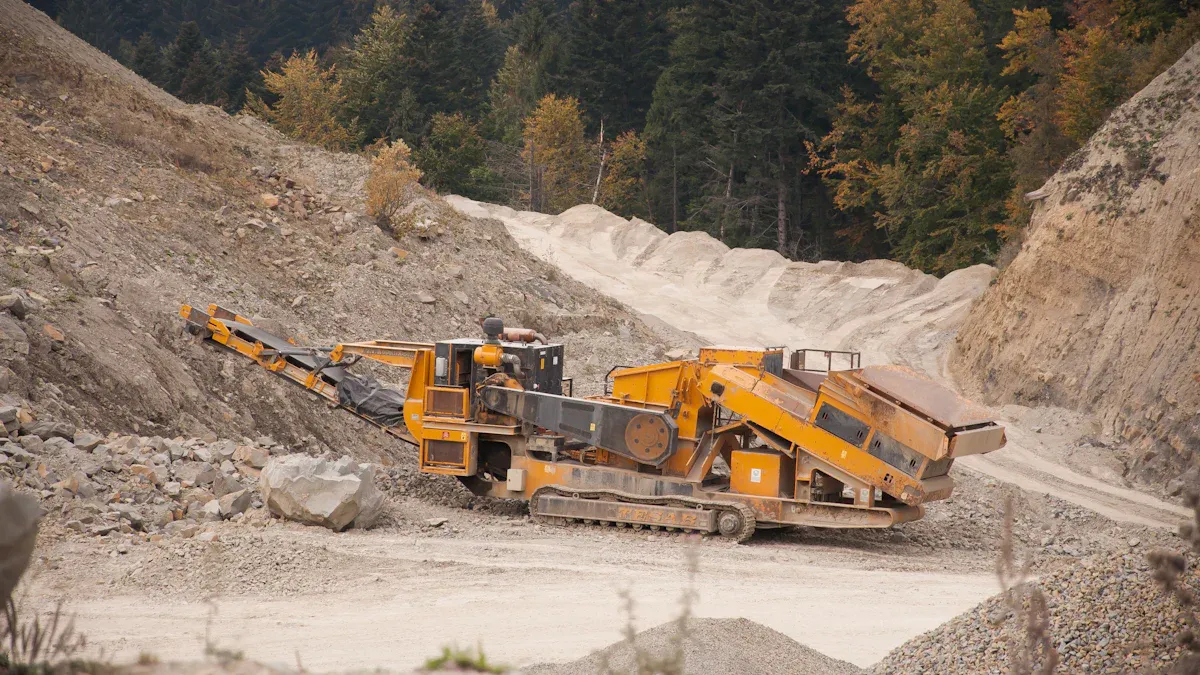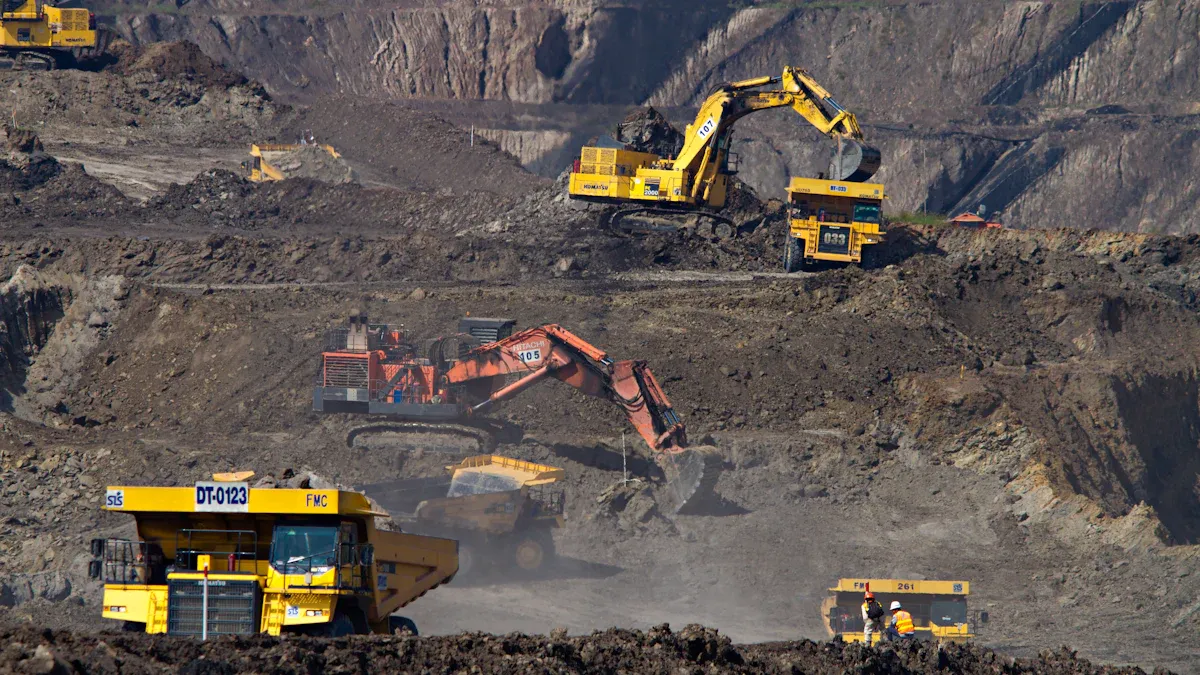
A cone crusher bucket transforms your material processing by combining efficiency, cost savings, and adaptability. These buckets handle secondary and tertiary crushing in hard-stone applications, offering unmatched versatility. You can configure them to meet specific needs, whether for prescreening, grading, or crushing. Faster setup times and reduced operating costs mean you’ll save time and money. Additionally, by streamlining material preparation, you’ll lower transport expenses and maximize productivity. With this tool, you can simplify operations while achieving superior results.
Tip: Coordinating mobile crushers with screens boosts efficiency and ensures seamless performance.

A cone crusher bucket offers several advantages that enhance your material processing tasks. It reduces transport costs by eliminating the need to move waste off-site. You can also save on material costs by reusing crushed debris as hardcore for construction projects. This bucket transforms small volume construction rubble into usable aggregate, which minimizes site traffic and delays. Its efficiency in recycling makes it an essential tool for sustainable construction practices.
You can use a cone crusher bucket across a wide range of applications. It works well for foundation laying, landscaping, and roadways. It also serves as a base layer for concrete, ensuring stability and durability. Whether you’re handling small volume construction rubble or preparing aggregate for larger projects, this bucket adapts to your needs. Its versatility makes it suitable for both residential and commercial construction tasks.
The cone crusher bucket streamlines your workflow, saving both time and money. By processing materials on-site, you reduce the need for transportation and external crushing services. This efficiency lowers operational costs and speeds up project timelines. For example, recycling construction debris into aggregate eliminates the expense of importing new material. With this bucket, you can complete tasks faster while maintaining high-quality results.
Tip: Use the table below to understand the broad range of benefits and applications:
Benefit/Application Description Cost Savings Reduces transport costs for removing waste and material costs for importing hardcore. Efficiency in Recycling Transforms construction debris into usable aggregate, minimizing site traffic and delays. Versatile Applications Suitable for foundation laying, landscaping, roadways, and as a base layer for concrete.

Proper preparation ensures your cone crusher bucket operates efficiently and safely. Start by inspecting the equipment for any visible damage or wear. Check the hydraulic system for leaks and ensure all connections are secure. Clean the bucket to remove any debris or residue from previous use. This prevents contamination and ensures smooth operation.
Before starting, validate the equipment's performance through operational qualification (OQ) and performance qualification (PQ). These procedures confirm that the bucket meets operational standards and functions reliably over time.
| Procedure Type | Description |
|---|---|
| Operational Qualification (OQ) | Validates that equipment operates correctly and meets user requirements. It involves testing various functions and establishing operational parameters. |
| Performance Qualification (PQ) | Ensures that equipment continuously complies with specifications and standards, providing proof of compliance and reliability over time. |
Tip: Always refer to the manufacturer’s manual for specific preparation guidelines. This ensures you follow the correct procedures for your equipment.
Attaching the cone crusher bucket to your machine requires precision. Begin by aligning the bucket with the mounting plate of your excavator or loader. Use the hydraulic controls to position the bucket securely. Once aligned, lock the bucket in place using the attachment pins or quick coupler system.
After securing the bucket, test the connection by gently moving the equipment. This ensures the bucket is firmly attached and ready for operation. A loose attachment can lead to accidents or equipment damage.
Note: Regularly inspect the attachment points for wear and tear. Replace worn parts immediately to maintain safety and efficiency.
Operating the cone crusher bucket requires attention to safety and efficiency. Always wear appropriate personal protective equipment (PPE), including gloves, goggles, and a hard hat. Before starting, ensure the work area is clear of obstacles and unauthorized personnel.
When processing material, feed it into the bucket gradually. Avoid overloading, as this can strain the equipment and reduce its lifespan. Monitor the hydraulic pressure and adjust the settings as needed to maintain o ptimal performance.
To maximize efficiency, coordinate the bucket's operation with other equipment on-site. For example, pairing the bucket with a mobile screen can streamline material processing and improve productivity.
Safety Reminder: Never operate the bucket near power lines or unstable ground. Always follow the safety guidelines provided by the manufacturer.
Processing materials with a cone crusher bucket requires careful attention to detail. This step ensures you achieve the desired results while maintaining efficiency. By following best practices, you can optimize the bucket's performance and reduce processing time.
Assess the Material
Begin by evaluating the type and size of the material you need to process. Different materials, such as concrete, asphalt, or stone, may require specific settings on the bucket. Smaller materials may process faster, while larger pieces might need pre-crushing or sorting.
Load Gradually
Feed the material into the bucket slowly and steadily. Overloading can strain the equipment and reduce its lifespan. A consistent flow ensures the bucket operates efficiently and prevents blockages.
Monitor Performance
Keep an eye on the bucket's performance during operation. Check the hydraulic pressure and adjust the settings as needed. If you notice any unusual sounds or vibrations, pause the operation and inspect the equipment.
Coordinate with Other Equipment
Pairing the cone crusher bucket with other tools, such as mobile screens or conveyors, can enhance productivity. This setup allows you to sort and process materials simultaneously, saving time and effort.
Using the cone crusher bucket effectively can lead to significant improvements in material processing. Studies show that optimal usage can reduce processing time by up to 65% in certain scenarios. For example:
- In systems with smaller data volumes, bucketing may not provide noticeable advantages.
- However, in larger-scale operations, such as those involving a star schema with a scale factor of 300, join optimization mechanisms can significantly enhance performance.
- These improvements result in reduced CPU usage and faster project completion times.
By applying these strategies, you can maximize the efficiency of your material processing tasks. This not only saves time but also minimizes wear and tear on your equipment.
Tip: Always clean the bucket after processing to prevent residue buildup. This practice ensures consistent performance and extends the bucket's lifespan.
Regular maintenance is essential to keep your cone crusher bucket in top condition. By following a consistent maintenance schedule, you can prevent unexpected breakdowns and extend the lifespan of your equipment. Start by inspecting the bucket after every use. Look for signs of wear, such as cracks or dents, and address them immediately. Clean the bucket thoroughly to remove any leftover material that could cause blockages or corrosion.
Lubrication plays a critical role in maintaining the bucket's moving parts. Use the manufacturer-recommended lubricants and apply them as specified in the manual. Neglecting lubrication can lead to increased friction, which reduces efficiency and accelerates wear.
Studies show that downtime caused by maintenance tasks often exceeds the time spent on actual repairs. For example:
- At the Sarcheshmeh Copper Mine, only 54% of downtime is due to direct repairs.
- The remaining 50% includes delays, preparation, diagnosis, and testing.
- Effective maintenance strategies can significantly reduce this downtime, improving overall equipment availability.
Tip: Keep a detailed maintenance log. This helps you track comp leted tasks and identify recurring issues, making it easier to plan future maintenance.
Even with regular maintenance, issues can arise. Knowing how to troubleshoot effectively can save you time and prevent minor problems from escalating. Start by identifying the problem. Observe the bucket's performance and look for unusual sounds, vibrations, or reduced efficiency.
Once you identify the issue, establish a theory about the probable cause. Test this theory by inspecting the suspected components. For example, if the bucket isn't crushing material effectively, check for blockages or worn teeth. After confirming the cause, create a plan to resolve the issue. Implement the solution and test the bucket to ensure it functions correctly.
Field studies highlight the importance of a structured troubleshooting process:
1. Identify the problem.
2. Establish a theory of probable cause.
3. Test the theory to determine the cause.
4. Develop a plan of action to resolve the issue.
5. Implement the solution or escalate if necessary.
6. Verify full system functionality and implement preventive measures.
7. Document findings and lessons learned.
Note: Always document your troubleshooting process. This creates a valuable reference for future issues and helps improve your problem-solving skills.
To get the most out of your cone crusher bucket, focus on optimizing its efficiency. Start by ensuring the bucket is properly attached and aligned with your equipment. Misalignment can reduce crushing performance and increase wear.
When processing material, feed it gradually and consistently. Overloading the bucket can strain the equipment and lead to uneven crushing. Pairing the bucket with complementary tools, such as mobile screens or conveyors, can further enhance productivity. This setup allows you to sort and process material simultaneously, saving time and energy.
Energy efficiency also plays a significant role in maximizing performance. Reports show that energy efficiency investments have reduced energy expenditures by approximately $800 billion annually in the U.S. Without these investments, energy consumption and carbon emissions would be 78% higher. By operating your bucket efficiently, you contribute to these savings while reducing your operational costs.
Tip: Train your team on best practices for using the bucket. A well-trained operator can significantly improve efficiency and reduce wear on the equipment.
Operating a cone crusher bucket safely is essential to protect yourself, your team, and your equipment. Following proper safety protocols minimizes risks and ensures smooth operations. Here are key safety guidelines to keep in mind:
Always wear the right PPE when operating or working near a cone crusher bucket. This includes:
- Hard hats to protect your head from falling debris.
- Safety goggles to shield your eyes from dust and flying particles.
- Gloves to prevent hand injuries when handling materials or equipment.
- Steel-toed boots to protect your feet from heavy objects.
Tip: Inspect your PPE regularly for damage. Replace worn-out gear immediately to ensure maximum protection.
Before starting, inspect the cone crusher bucket and the host machine. Look for visible damage, loose connections, or hydraulic leaks. Check the attachment points to ensure the bucket is securely fastened.
| Inspection Checklist | What to Look For |
|---|---|
| Hydraulic System | Leaks, pressure levels, and hose damage. |
| Bucket Teeth and Edges | Cracks, wear, or missing parts. |
| Attachment Points | Loose pins or couplers. |
Note: A thorough inspection prevents accidents caused by equipment failure.
Keep the work area free of obstacles and unauthorized personnel. Mark the operational zone with cones or barriers to alert others. Ensure the ground is stable and free of hazards like loose rocks or uneven surfaces.
Safety Reminder: Never operate the bucket near power lines or on unstable ground. These conditions increase the risk of accidents.
Load materials into the bucket gradually. Avoid overloading, as this can strain the equipment and create safety hazards. Use the bucket's capacity guidelines to determine the appropriate load size.
Warning: Overloading can cause the bucket to tip or malfunction, leading to serious injuries.
Pay close attention to the bucket's performance while in use. Watch for unusual sounds, vibrations, or hydraulic pressure changes. Stop immediately if you notice any irregularities and inspect the equipment.
Tip: Regular monitoring helps you identify and address issues before they escalate.
Ensure all operators and team members receive proper training on using the cone crusher bucket. They should understand the equipment's functions, safety features, and emergency procedures.
Did You Know? Studies show that well-trained operators reduce workplace accidents by up to 70%.
Have an emergency plan in place. Ensure fire extinguishers and first aid kits are easily accessible. Train your team on how to respond to equipment malfunctions or accidents.
Callout: Quick action during emergencies can save lives and minimize damage.
By following these safety guidelines, you can create a safer work environment and ensure the efficient operation of your cone crusher bucket. Always prioritize safety over speed to protect yourself and your team.
Using a cone crusher bucket effectively can transform your material processing tasks. It reduces costs, improves efficiency, and supports sustainable practices. Proper operation and regular maintenance ensure the equipment performs reliably and lasts longer. By following the tips shared in this guide, you can achieve better results and boost productivity. Take the time to train your team and implement these strategies. You’ll see noticeable improvements in your workflow and project outcomes.
A cone crusher bucket processes materials like concrete, asphalt, stone, and rubble. It works well for recycling construction debris into usable aggregate. You can also use it for landscaping and roadwork projects.
Tip: Always check the material's size and type to ensure compatibility with your bucket.
Inspect and clean the bucket after every use. Perform a detailed maintenance check weekly. Lubricate moving parts as recommended by the manufacturer. Regular maintenance prevents breakdowns and extends the equipment's lifespan.
Note: Keep a maintenance log to track completed tasks and i dentify recurring issues.
No, you must ensure compatibility between the bucket and your machine. Check the mounting plate size and hydraulic system specifications. Refer to the manufacturer’s guidelines for proper attachment and operation.
Warning: Using incompatible equipment can cause damage or safety hazards.
Wear proper PPE, including gloves, goggles, and a hard hat. Inspect the bucket and work area before starting. Avoid overloading the bucket and keep unauthorized personnel away. Monitor the equipment for unusual sounds or vibrations.
Safety Reminder: Never operate near power lines or unstable ground.
Feed materials gradually and avoid overloading. Pair the bucket with complementary tools like mobile screens. Train your team on best practices for operation. Regular maintenance also ensures optimal performance.
Did You Know? Proper training can reduce equipment wear and improve efficiency by up to 30%.